As you learned in the last section, wind is a clean, abundant, and renewable energy resource that can be tapped to produce electricity. This section explores how wind is generated and introduces you to two types of wind - local and global. We'll also explore ways local topography affects wind, introducing you to two key concepts: ground drag and turbulence. This information provides the practical knowledge you will need to select the best site for a wind turbine and the optimum tower height.
What is Wind?
Wind is air in horizontal motion across the Earth's surface. All winds are produced by differences in air pressure between two regions. Differences in pressure result from differential heating of the surface of the Earth. Heating, of course, is caused by sunlight striking the Earth's surface.
Like most other forms of energy in use today, even coal, oil and natural gas, wind is a product of sunlight - solar energy. Some wind advocates, refer to wind as "the other solar energy" or "second hand solar energy." Let's begin by looking at two types of local winds:
(1) offshore and onshore winds and (2) mountain-valley breezes.
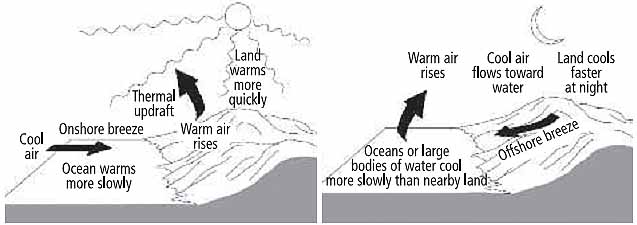
ill. 1a and 2.1b: Onshore and offshore breezes. Onshore (a) and offshore
(b) breezes occur along the coastlines of major lakes and oceans.
Offshore and Onshore Winds
Offshore and onshore winds are generated along the shores of large lakes, such as the Great Lakes of North America, and along the flows from the land to the water at night (Fig 1b). The result is an offshore breeze: steady winds that flow from land to water.
Offshore and onshore breezes operate day in and day out on sunny days, providing a steady supply of wind energy. Because off shore and onshore winds are fairly reliable, coastal regions of the world are often ideal locations for small (and large) wind turbines.
Coastal winds are more consistent than winds over the interior of continents and also tend to be more powerful because of the relatively smooth and unobstructed surface of open waters. That is to say, wind moves rapidly over water because lakes and coastal waters provide very little resistance to its flow, unlike forests or cities and suburbs, which dramatically lower surface wind speeds.
Mountain-Valley Breezes
Like coastal winds, mountain-valley breezes arise from the differential heating of the Earth's surface. To understand how these winds are formed, let's begin in the morning.
As the Sun rises on clear days, sunrays strike the valley floor and begin heating the ground, valley walls and mountains. As the ground and valley walls begin to warm, the air above them warms.
It then expands and begins to flow upward. This process is known as convection. (Convection is the transfer of heat in a fluid or a gas that is caused by the movement of the heated air or fluid itself.) While some of this warm air rises vertically, mountain valleys also tend to channel the solar-heated air through the valley toward the mountains (___ 2.2). As the warmed air moves up a valley, cooler air from surrounding areas flows in to replace it. This wind is known as a valley breeze.
Throughout the morning and well into the afternoon, breezes flow up-valley - from the valley floor into the mountains. These breezes tend to reach a crescendo in the afternoon. When the Sun sets, however, the winds reverse direction, flowing down valley.
Winds flow in reverse at night because the mountains cool more quickly than the valley floor. Cool, dense air (high-pressure air) from the mountains sinks and flows down through the valleys like the water in a mountain stream, creating steady and often predictable down-valley or mountain breezes.
Together, valley and mountain winds are known as mountain valley breezes. As a rule, mountain breezes (down-flowing winds) tend to be stronger than daytime valley breezes.
Mountain-valley breezes typically occur in the summer, a time when solar radiation is greatest. They also typically occur on calm days when the prevailing winds (larger regional winds, which will be discussed shortly) are weak or nonexistent.
Mountain-valley winds also form in the presence of prevailing winds - for example, when a storm moves through an area. In such instances, mountain or valley winds may "piggy back" on the prevailing winds, creating even more powerful (and hence higher energy) winds. When consistently flowing in the same direction, such winds can provide a great deal of power that can be tapped to produce an abundance of electricity.

Fig. 2a and 2b: Mountain-Valley Breezes. Mountain-valley winds can provide
a reliable source of wind power if conditions are just right. (a) Up-valley
winds. (b) Down-valley winds.
Large-Scale Wind Currents
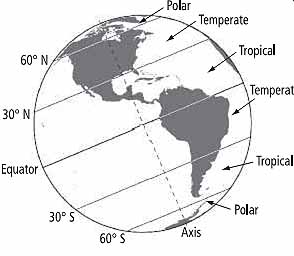
Fig. 3: Climate Zones.
The Earth is divided into three climate zones in each hemisphere. In the Northern Hemisphere, warm air from the tropics flows northward by convection, creating the global circulation pattern.
Local winds can be a valuable source of energy. The winds on which most people rely, however, are those produced by much larger air masses that result from regional and global air circulation. They create dominant wind-flow patterns, known as prevailing winds.
Prevailing winds, like local winds, are created by the differential heating of the Earth's surface, but on a much larger scale. Here's how they are formed: As shown in ___ 2.3, the Earth is divided into three climatic zones: the tropics, temperate zones and poles.
Because the tropics are more directly aligned with the Sun through out the year, they receive more sunlight and are, therefore, the warmest regions on Earth.
The temperate zones lie outside the tropics, in both the Northern and Southern Hemispheres. They receive less sunlight than the tropics and so are cooler. The North and South poles receive the least amount of sunlight and are the coolest regions of our planet.
As shown in ___ 2.4a, global air circulation is created by hot air produced in the tropics. This air expands and rises (as in local air circulation patterns). Cool air from the northern regions - as far north as the poles - moves in to fill the void. The result is huge air currents that flow from the poles to the equator.
Although air generally flows from the North and South poles toward the equator, circulation patterns are a bit more complicated.
In the Northern Hemisphere, some of the warm air moving north ward cools and sinks back to the Earth's surface, as shown in ___ 2.4b. It then flows back toward the equator creating the trade winds.
Because the trade winds blow quite consistently, they are a potentially huge and reliable source of energy for residents and nations fortunate enough to lie in the winds' path.
As shown in ___ 2.4b, a substantial amount of the north ward-moving air continues on toward the North Pole, traveling over the temperate zone.
The figure also shows air masses flowing northward across the temperate zone split into two, creating higher- and lower-level winds. When the upper winds reach the North Pole, this cold air sinks and then flows southward back toward the equator.
If no other forces were at work, winds flowing back to the equator would flow from north to south. As shown in ___ 2.4c, they don't. Other factors influence the movement of air masses across the surface of the planet. One of the most significant is the Earth's rotation, which results in a phenomenon known as the Coriolis effect.
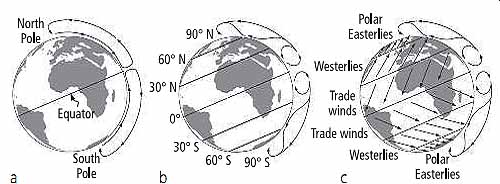
ill. 4: Global Air Circulation. (a) As shown here, warm tropical air rises and flows toward the poles. Cold polar air flows toward the equator. (b)
Warm tropical air loses some of its heat and sinks toward the Earth's surface,
then flows back toward the equator, creating the trade winds. Air masses
moving over the temperate zone split into upper and lower winds. (c) Wind
patterns caused by the Coriolis effect, resulting from the rotation of the
Earth on its axis.
The Coriolis Effect
To understand why prevailing winds deviate from the expected pat terns based solely on convection, let's start with the trade winds. As shown in ___ 2.4c, the trade winds in the Northern Hemisphere flow not from north to south, as you might expect, but from the northeast to southwest. Why? Because they are "deflected" by the Earth's rotation.
In reality, the Earth's rotation doesn't deflect winds. It makes it appear as if the winds have been deflected. The apparent deflection in wind direction in the tropics is a planetary sleight of hand, an illusion produced by the rotation of the Earth on its axis. To understand this phenomenon, consider a simple example. Imagine that you board a plane leaving the North Pole. The pilot plots a course that will take you due south toward an airfield on Sri Lanka just south of India. If the pilot flies the plane due south the entire trip, however, the plane will end up somewhere over the Arabian Sea because of the Earth's rotation.
As shown in ___ 2.5, as the plane travels south, the Earth rotates beneath it. The Earth rotates eastward. If you plot the flight path of the plane it appears to have been deflected. In reality, it only looks that way.
The apparent deflection of the plane's path is the Coriolis effect. In the Northern Hemisphere, the deflection is to the right of the direction of travel. In the Southern Hemisphere, the deflection is to the left.
Winds flowing north or south also appear to be deflected thanks to the Coriolis effect. The south-flowing trade winds, for instance, appear to flow from northeast to southwest.
In the temperate zone, as shown in ___ 2.4c, the low-level north-flowing winds that sweep across the surface of the Earth flow across the North American continent not from south to north but from the southwest to northeast. These are the prevailing south westerly winds that blow across the Great Plains of North America.
Many a wind farm and many a small wind operation depend on them.
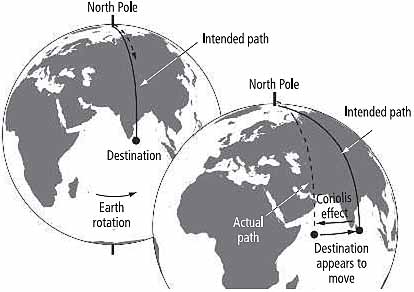
ill. 5: The Coriolis Effect. The rotation of the Earth causes an apparent
deflection in the path of winds. This can be understood by observing the
flight of a plane that begins at the North Pole and heads south toward Sri
Lanka. The plane appears to veer off course. It hasn't. The Earth's rotation
makes it look that way.
Wind from Storms
Winds are often associated with storms. Storms, in turn, are produced when high-pressure and low-pressure air masses collide.
High and low pressure zones move across the continents.
Low-pressure air masses originate in the tropics. They are created by the huge influx of solar energy in these regions. Huge masses of low-pressure air frequently break away and migrate northward, sweeping across the North American continent.
High-pressure air masses originate in the North and South poles, regions of more or less permanent cold, high-pressure air. Like warm tropical air, huge masses of cold Arctic air also break loose and drift southward, sweeping across the Northern Hemisphere.
High-pressure and low-pressure air masses, often measuring 500 to 1,000 miles in diameter, move across continents. The movement of high- and low-pressure air masses across continents is steered by prevailing winds and by the jet stream (high altitude winds). As these air masses collide, they produce an assortment of weather, often accompanied by winds. As with all other forms of wind, storm winds are created by differences in pressure between high- and low pressure air masses. The greater the difference in pressure between a high-pressure air mass and a "neighboring" low-pressure air mass, the stronger the winds. In some cases, these winds contain an enormous amount of energy.
Friction, Turbulence and Smart Siting
Wind does not flow smoothly over the Earth's surface. It encounters resistance, known as friction. This results in a phenomenon called ground drag. Ground drag is caused by friction when air flows across a surface.
Friction is the force that resists movement of one material against another. You create friction, for example, when you rub your hands together. When wind flows across land or water, friction occurs. This reduces the speed at which air moves over a surface.
Ground drag due to friction, however, varies considerably, depending on the roughness of the surface. The rougher or more irregular the surface, the greater the friction. As a result, air flowing across the surface of a lake generates less friction than air flowing over a meadow. Air flowing over a meadow generates less friction than air flowing over a forest.
Friction extends to a height of about 1,650 feet (500 meters).
However, the greatest effects are closest to Earth's surface - the first 60 feet over a relatively flat, smooth surface. Over trees, the greatest effects occur within the first 60 feet (18 meters) above the tree line.
Friction has a dramatic effect on wind speed at different heights.
For instance, a 20-mile-per-hour wind measured at 1,000 feet above land covered with grasses flows at 5 miles per hour 10 feet above the surface. It then increases progressively until it breaks loose from the influence of the ground drag or friction. ___ 2.6 shows the difference in wind speed at 50 meters (165 feet) to 5 meters (16.5 feet). ___ 2.7 compares wind speed over a grassy area to wind speed over a forest, a significantly rougher surface. Notice that the wind speed increases more rapidly above the forest.
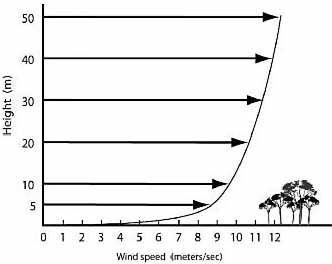
ill. 6: Effect of Ground Drag.
Winds move more slowly at ground level due to friction.
Friction diminishes with height, so wind speed increases.
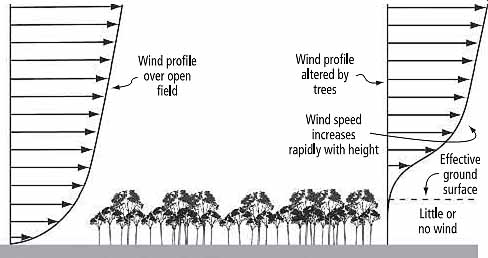
ill. 7: Wind Speed vs. Height. These graphs compare the wind speed over
a grassy area and a forest. As you can see, a forest virtually eliminates
ground level winds. As a result, the effective ground level shifts upward.
Note that the wind speed increases more rapidly with height over a forest
than over a grassy area. Wind turbines placed well above the tree line can
avail them selves of powerful winds.
Ground drag dramatically influences wind speed near the surface of the ground where residential wind generators are located.
Because the effects of friction decrease with height above the surface of the Earth, savvy installers typically mount their wind machines on towers 80 to 120 feet high (24 to 37 meters), or even as high as 180 feet (55 meters) in forested regions, so their turbines are out of the most significant ground drag. At these heights, the winds are substantially stronger than near the ground. As discussed shortly, a small increase in wind speed can result in a substantial increase in the amount of power that's available from the wind and the amount of electricity a wind generator produces. Mounting a wind turbine on a tall tower therefore maximizes the electrical out put of the machine. Placing a turbine on a short tower has just the opposite effect. It places the generator in the weaker winds and is a bit like mounting solar panels in the shade.
Another natural phenomenon that affects the output of most wind turbines is turbulence. Turbulence is produced as air flowing across the Earth's surface encounters objects, such as trees or buildings.
They interrupt the wind's smooth laminar flow, causing it to tumble and swirl, the same way rocks in a stream interrupt the flow of water (___ 2.8). Rapid changes in wind speed occur behind large obstacles and winds may even flow in the direction opposite to the wind.
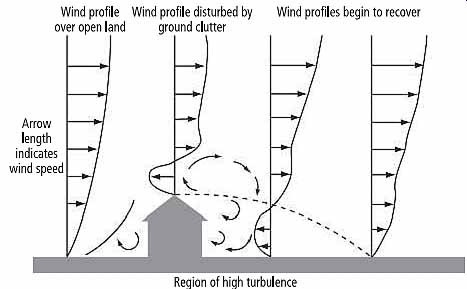
This highly disorganized wind flow is referred to as turbulence.
Turbulent wind flows wreck havoc on wind machines, especially the less expensive, lighter-weight wind turbines often installed on short towers by cost-conscious homeowners. Buffeted by turbulent winds, wind machines hunt around on the top of their towers, constantly seeking the strongest wind, starting and stopping repeatedly.
This decreases the amount of electricity a turbine generates.
Turbulence also causes vibration and unequal forces on the wind turbine, especially the blades, that may weaken and damage the machine. Turbulence, therefore, increases wear and tear on wind generators and , over time, can destroy a turbine. The cheaper the turbine, the more likely it will be destroyed in a turbulent location. A home owner may find that a machine he or she had hoped would produce electricity for ten to twenty years only lasted two to four years.
Turbulence is to a wind machine like potholes to your car.
When considering a location to mount a wind turbine, be sure to consider turbulence-generating obstacles such as silos, trees, barns, houses and other wind turbines. Proper location is the key to avoiding the damaging effects of turbulence. Turbulence can also be minimized by mounting a wind turbine on a tall tower. In sum, then, mounting a wind generator on a tall tower offers four benefits: (1) it situates the wind generator in the stronger higher energy-yielding winds, substantially increasing electrical production, (2) it raises the machine out of damaging turbulent winds, (3) it decreases the wind turbine's maintenance and repair requirements, and (4) it increases the wind turbine's useful lifespan substantially, perhaps tenfold. Longer turbine life means less overall expense - and more electricity from your investment.
As shown in ___ 2.9, all obstacles create a downstream zone of turbulent air, or "turbulence bubble." It typically extends vertically about twice the height of the obstruction and extends downwind approximately 15 to 20 times the height of the obstruction. A 20 foot-high house creates a turbulence bubble that extends 40 feet above the ground and 300 to 400 feet downwind. As illustrated in ___ 2.9, the turbulence bubble also extends upwind - about two times the object's height. In this case, the upwind bubble extends about 40 feet upwind from the house. The upstream portion of the bubble is created by wind backing up as it strikes the obstacle - much like water flowing against a rock in a river.

ill. 9: Turbulence Bubble. The turbulence bubble extends upwind, downwind, and even above the clutter. The bubble shifts when wind direction changes.
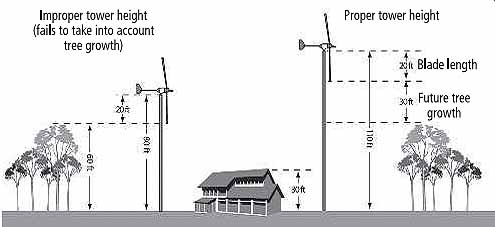
ill. 10: Treelines and Wind Speed. Siting a wind turbine in an open area
surrounded by trees is possible. As explained in the text, the top of the
tree line is the effective ground level. The turbine needs to be mounted
well above the trees to perform optimally.
To avoid costly mistakes, installers recommend that wind machines be mounted so that the complete rotor (the hub and the blades) of the wind generator is at least 30 feet (9 meters) above the closest obstacle within 500 feet (about 150 meters), or a tree line in the area, whichever is higher (___ 2.10). Don't listen to those who recommend lesser heights. Many unhappy customers will attest to that! If your home or business is in an open field surrounded by trees, the wind turbine needs to be well above the tree line (___ 2.10).
Remember, too, to account for growth of trees over the 20- to 30 year life span of your wind system when determining tower height.
The Mathematics of Wind Power
To understand how important it is to mount a wind turbine on a tall tower, consider a simple mathematical equation. It's called the power equation and is used to calculate the power available from the wind. This equation shows us that three factors influence the output of a wind energy system: (1) air density, (2) swept area, and (3) wind speed - all explained shortly.
The power equation is: P = ½d x A x V^3.
P stands for the power available in the wind (not the power a wind generator will extract - that's influenced by efficiency and other factors). Density of the air is d. Swept area is A. Wind speed is V.
Air Density
Air density is the weight of air per unit volume, which varies with elevation. As a general rule, anticipate a decrease in the air density of about 3 percent per 1,000 feet (300 meters) increase in elevation.
As a result, air density doesn't affect the power available from the wind until elevation reaches 2,500 feet (760 meters) above sea level.
At 3,000 feet (about 910 meters) above sea level, the air density is 9 percent lower than at sea level. At 5,000 feet (about 1,525 meters) air density declines by about 15 percent.
Air density is also a function of relative humidity, although the difference between a dry and humid area is usually negligible.
Temperature also affects the density of air. Warmer air is less dense than colder air. Consequently, a wind turbine operating in cold (denser) winter winds would produce slightly more electricity than the same wind turbine in warmer winds blowing at the same speed.
Although temperature and humidity affect air density, they are not factors we can change. Installers must be aware of the reduced energy available at higher altitudes, however, so they don't create unrealistic expectations for a wind system.
Although density is not a factor we can control, wind installers do have control over a couple of other key factors, notably, swept area (A) and wind speed - both of which have a much greater impact on the amount of power available to a wind turbine and the electrical output of the machine than air density.
Swept Area
Swept area is the area of the circle that the blades of a wind machine create when spinning. It is a wind machine's collector surface. The larger the swept area, the more energy a wind turbine can capture from the wind. Swept area is determined by blade length. The longer the blades, the greater the swept area. The greater the swept area, the greater the electrical output of a turbine. As the equation suggests, the relation ship between swept area and power output is linear. Theoretically, a ten percent increase in swept area will result in a ten percent increase in electrical production. Doubling the swept area doubles the output. When shopping for a wind turbine, always convert blade length to swept area, if the manufacturer has not done so for you (they usually do). Swept area can be calculated using the equation A = pi r^2 . In this equation, A is the area of the circle, the swept area of the wind turbine. The Greek symbol is pi, which is a constant: 3.14.
The letter r stands for the radius of a circle, the distance from the center of the circle to its outer edge. For a wind turbine, radius is usually about the same as the length of the blade.
Because swept area is a function of the radius squared, a small increase in radius, or blade length, results in a large increase in swept area. As an example, a wind generator with an 8-foot blade has a swept area of 200 square feet. A wind generator with a 25 percent longer blade, that is, a 10-foot blade, has a 314 square-foot swept area. Thus, a 25 percent increase in blade length results in a 57 per cent increase in swept area and , theoretically, a 57 percent increase in electrical production.
==Shopping Tip==
Because swept area is such an important determinant of the output of a wind turbine, we strongly recommend focusing more on the swept area of a wind turbine than on its rated power - at least until the industry can come up with a standardized way of measuring and reporting rated power.
==
Wind Speed
Although swept area is more important than density, wind speed is even more important in determining the output of a wind turbine.
That's because the power available from the wind increases with the cube of wind speed. This relationship is expressed in the power equation as V^3 or V x V x V - wind speed multiplied by itself three times.
Consider an example: Suppose that you mount a wind machine 18 feet (5.5 meters) above the ground surface on the grasslands of Nebraska. Suppose that the wind is blowing at eight miles per hour (3.6 meters per second). A friend, who knows how important it is to mount a wind machine on a tall tower, installs an identical wind turbine on a 90-foot (27-meter) tower. When the wind is blowing at 8 mph where your turbine flies at 18 feet, an anemometer on your friend's 90-foot tower indicates that the wind is blowing at 10 miles per hour. Wind speed is 25 percent higher. What's the difference in available power? The power available in the wind can be approximated by multiplying the wind speeds by themselves three times. (Units aren't important for this comparison.) For the lower turbine the result is 8 x 8 x 8 or 512. The power available to the wind turbine mounted on a 90-foot tower is 10 cubed or 10 x 10 x 10 which is 1,000. Thus, a two-mile-per-hour increase in wind speed, a paltry 25 percent increase, doubles the available power. Put another way, a 25 percent increase in wind speed yields an increase of nearly 100 percent. The important lesson is that because power is function of V^3, a small increase in wind speed results in a very large increase in the power available to a wind turbine. This can result in a very large increase in the electrical output of a wind turbine.
Although winds are out of our control, homeowners can affect the wind speed at their wind turbines by choosing the best possible site and by installing their machines on the tallest towers.
Closing Thoughts
Wind is a tremendous resource available in many parts of the world thanks to the Sun's unequal heating of the Earth's surface.
Depending on your location, you may be able to take advantage of offshore and onshore winds or perhaps mountain-valley winds.
Prevailing winds and winds that are created between high-pressure and low-pressure air masses could become your ally in reducing your carbon footprint and meeting your own needs sustainably.
Don't forget to take into account ground drag that slows wind speed and robs you of additional energy and damages your wind turbine.
Site wisely and you'll be repaid day after day after day.
Next: Wind Energy System